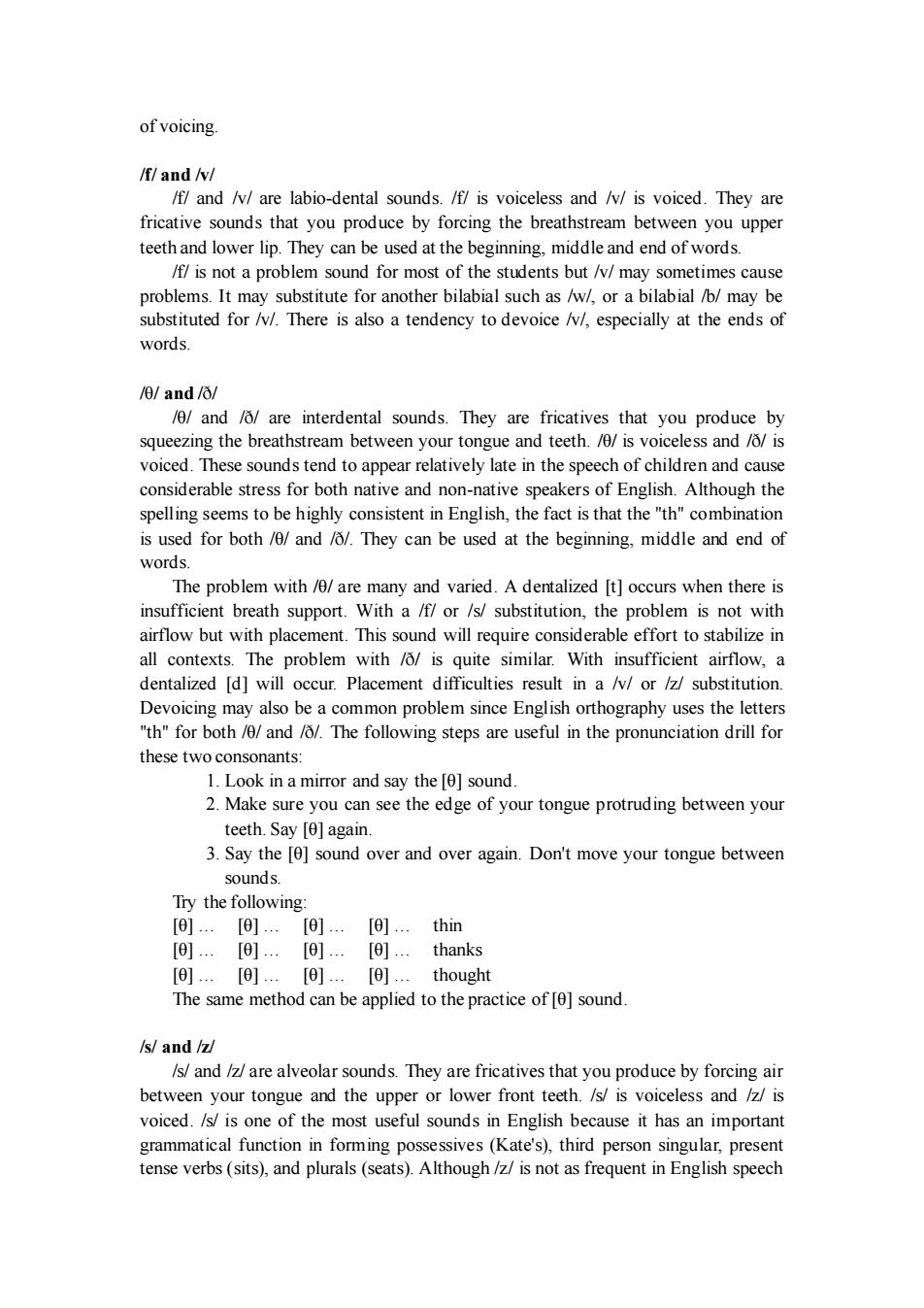正在加载图片...

of voicing /f/and /v/ /f/and /v/are labio-dental sounds./f/is voiceless and /v/is voiced.They are fricative sounds that you produce by forcing the breathstream between you upper teeth and lower lip.They can be used at the beginning,middle and end of words. /f/is not a problem sound for mos f the stude nts but/v/may som etimes cause problems.It may substitute for another bilabial such as //or a bilabial /b/may be substituted for /v/.There is also a tendency to devoice //especially at the ends of words. 10/and// 0/and are interdental sounds.They are fricatives that you produce by squeezing the breathstream between your tongue and teeth./0/is voiceless and /is voiced.These sounds tend to appear relatively late in the speech of children and cause considerable stress for both native and non-native speakers of English.Although the spelling seems to be highly consistent in English,the fact is that the"th"combination is used for both /0/and//.They can be used at the beginning.middle and end The problem with/0/are many and varied.A dentalized [tl occurs when there is insufficient breath support.With a /f/or/s/substitution,the problem is not with airflow but with placement.This sound will require considerable effort to stabilize in all problem with /o/is quite similar.With insuffic en Devoicing may also be a common problem since English orthography uses the letters "th"for both/0/and //The following steps are useful in the pronunciation drill for these two consonants: 1.Look in a mirror and say the [sound 2.Make sure you can see the edge of your tongue protruding between your teeth.Say[θagain 3.Say the [0]sound over and over again.Don't move your tongue between sounds Try the following [el thin [0.[0].[0]. 0. thanks [.[].[o].[0],thought The same method can be applied to the practice of [sound. Is/and s/andare alveolar sounds.They are fricatives that you produce by forcing ai between your tongue and the upper or lower front teeth./s/is voiceless and/is voiced./s/is one of the most useful sounds in English because it has an important grammatical function in forming possessives(Kate's),third person singular.present tense verbs(sits),and plurals(seats).Although//is not as frequent in English speechof voicing. /f/ and /v/ /f/ and /v/ are labio-dental sounds. /f/ is voiceless and /v/ is voiced. They are fricative sounds that you produce by forcing the breathstream between you upper teeth and lower lip. They can be used at the beginning, middle and end of words. /f/ is not a problem sound for most of the students but /v/ may sometimes cause problems. It may substitute for another bilabial such as /w/, or a bilabial /b/ may be substituted for /v/. There is also a tendency to devoice /v/, especially at the ends of words. /θ/ and /ð/ /θ/ and /ð/ are interdental sounds. They are fricatives that you produce by squeezing the breathstream between your tongue and teeth. /θ/ is voiceless and /ð/ is voiced. These sounds tend to appear relatively late in the speech of children and cause considerable stress for both native and non-native speakers of English. Although the spelling seems to be highly consistent in English, the fact is that the "th" combination is used for both /θ/ and /ð/. They can be used at the beginning, middle and end of words. The problem with /θ/ are many and varied. A dentalized [t] occurs when there is insufficient breath support. With a /f/ or /s/ substitution, the problem is not with airflow but with placement. This sound will require considerable effort to stabilize in all contexts. The problem with /ð/ is quite similar. With insufficient airflow, a dentalized [d] will occur. Placement difficulties result in a /v/ or /z/ substitution. Devoicing may also be a common problem since English orthography uses the letters "th" for both /θ/ and /ð/. The following steps are useful in the pronunciation drill for these two consonants: 1. Look in a mirror and say the [θ] sound. 2. Make sure you can see the edge of your tongue protruding between your teeth. Say [θ] again. 3. Say the [θ] sound over and over again. Don't move your tongue between sounds. Try the following: [θ] . [θ] . [θ] . [θ] . thin [θ] . [θ] . [θ] . [θ] . thanks [θ] . [θ] . [θ] . [θ] . thought The same method can be applied to the practice of [θ] sound. /s/ and /z/ /s/ and /z/ are alveolar sounds. They are fricatives that you produce by forcing air between your tongue and the upper or lower front teeth. /s/ is voiceless and /z/ is voiced. /s/ is one of the most useful sounds in English because it has an important grammatical function in forming possessives (Kate's), third person singular, present tense verbs (sits), and plurals (seats). Although /z/ is not as frequent in English speech